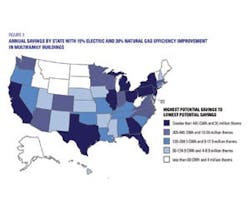$3.4B at Stake for Efficiency Measures in Multifamily Buildings
Building owners and utilities stand to save over $3.4 billion in energy costs if they work together to improve multifamily structures, according to a report by the American Council for an Energy Efficient Economy (ACEEE), a nonprofit advocating energy efficiency, and CNT Energy, a sustainability think tank.
Due to the complexity of the utility industry, there is no one incentive that will attract utilities and building owners nationwide, according to Engaging as Partners in Energy Efficiency: Multifamily Housing and Utilities.
However, some utilities are working with building owners to streamline data collection. For example, ComEd in Illinois provides free benchmarking for commercial customers. Partnerships like these offer savings for buildings and the opportunity for the utility to shut down old, inefficient power plants or avoid building new ones.
Replacing aging equipment with more efficient ENERGY STAR-rated models is a vital step for building owners, the study noted. In some areas, multifamily buildings may be eligible for lighting or appliance rebates and weatherization programs.
A few utilities have developed programs for multifamily buildings, but many don’t recognize multifamily properties as separate from residential and commercial properties. The study offers three strategies to make energy efficiency more attractive to utilities:
- Cost recovery for efficiency programs. Once a utility’s program is approved by the state commission overseeing it, the cost of the program is incorporated into rates.
- Decouple revenues from sales. Traditional utility regulation uses rate cases to establish revenue requirements and divides this by expected sales to determine rates. If sales are lower than expected (due to efficiency measures, for example), the utility loses revenue.
- Provide incentives. Utility shareholders earn returns on investments in power plant and distribution infrastructure. An efficiency incentive would level the playing field.
